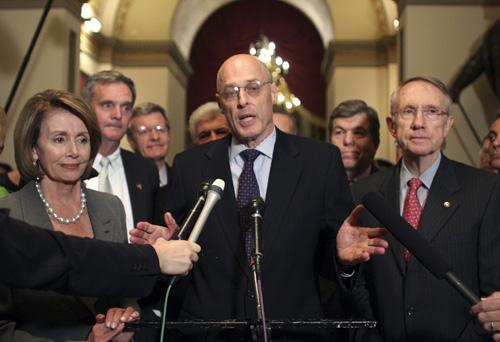Congress proposes revised bailout plan

Secretary of the Treasury Henry Paulson, center, announces a tentative deal on legislation regarding the financial crisis on Sunday. Lauren Victoria Burke, The Associated Press
September 29, 2008
WASHINGTON – Congressional leaders and the White House agreed Sunday to a $700 billion rescue of the ailing financial industry after lawmakers insisted on sharing spending controls with the administration of George W. Bush.
The biggest U.S. bailout in history won the tentative support of both presidential candidates and goes to the House for a vote Monday.
Bush called the vote a difficult one for lawmakers but said he is confident Congress will pass it. “Without this rescue plan, the costs to the American economy could be disastrous,” Bush said in a written statement released by the White House.
The plan, held up for days by negotiations between Democrats and Republicans, would give the administration broad power to use taxpayers’ money to purchase billions of home mortgage-related assets held by cash-starved financial firms.
Flexing its political muscle, Congress insisted on a stronger hand in controlling the money than the White House had wanted. Lawmakers had to navigate between angry voters with little regard for Wall Street and administration officials who warned that inaction would cause the economy to seize up and spiral into recession.
Get The Daily Illini in your inbox!
A deal in hand, Capitol Hill leaders scrambled to sell it to colleagues in both parties and acknowledged they were not certain it would pass. “Now we have to get the votes,” said Sen. Harry Reid, the majority leader and a Democrat from Nevada.
The final legislation was released Sunday evening. House Republicans and Democrats met privately to review it and decide how they would vote. “This isn’t about a bailout of Wall Street, it’s a buy-in, so that we can turn our economy around,” said House Speaker Nancy Pelosi, a California Democrat.
The largest government intervention in financial markets since the Great Depression casts Washington’s long shadow over Wall Street. The government would take over huge amounts of devalued assets from beleaguered financial companies in hopes of unlocking frozen credit.
“I don’t know of anyone here who wants the center of the economic universe to be Washington,” said a top negotiator, Sen. Chris Dodd, chairman of the Senate Banking, Housing and Urban Affairs Committee.
But, he added, “The center of gravity is here temporarily. … God forbid it’s here any longer than it takes to get credit moving again.”
The plan would let Congress block half the money and force the president to jump through some hoops before using it all. The government could get at $250 billion immediately, $100 billion more if the president certified it was necessary, and the last $350 billion with a separate certification – and subject to a congressional resolution of disapproval.
Still, the resolution could be vetoed by the president, meaning it would take extra-large congressional majorities to stop it.
Lawmakers who struck a post-midnight deal on the plan with Treasury Secretary Henry Paulson predicted final congressional action might not come until Wednesday.
The proposal is designed to end a vicious downward spiral that has battered all levels of the economy. Hundreds of billions of dollars in investments based on mortgages have soured and cramped banks’ willingness to lend.
“This is the bottom line: If we do not do this, the trauma, the chaos and the disruption to everyday Americans’ lives will be overwhelming, and that’s a price we can’t afford to risk paying,” Sen. Judd Gregg, the chief Senate Republican in the talks, told The Associated Press. “I do think we’ll be able to pass it, and it will be a bipartisan vote.”
A breakthrough came when Democrats agreed to incorporate a GOP demand – letting the government insure some bad home loans rather than buy them. That would limit the amount of federal money used in the rescue.
Another important bargain, vital to attracting support from centrist Democrats, would require that the government, after five years, submit a plan to Congress on how to recoup any losses from the companies that got help.
“This is something that all of us will swallow hard and go forward with,” said Republican presidential nominee John McCain. “The option of doing nothing is simply not an acceptable option.”
His Democratic rival Barack Obama sought credit for taxpayer safeguards added to the initial proposal from the Bush administration. “I was pushing very hard and involved in shaping those provisions,” he said.
Later, at a rally in Detroit, Obama said, “it looks like we will pass that plan very soon.”
House Republicans said they were reviewing the plan.
As late as Sunday afternoon, Republicans regarded the deal as “a proposal that is promising in principle, but that is still not final,” said Antonia Ferrier, a spokeswoman for Missouri Rep. Roy Blunt, the top House Republican negotiator.
“It’s not a bill that any one of us would have written. It’s a much better bill than we got. It’s not as good as it should be,” said Democratic Rep. Barney Frank of Massachusetts, the House Financial Services Committee chairman. Many feel that companies will be repaired and ordianary people will still suffer, lawmakers in both parties say the plan is vital to ensure their constituents don’t pay for Wall Street’s mistakes.






